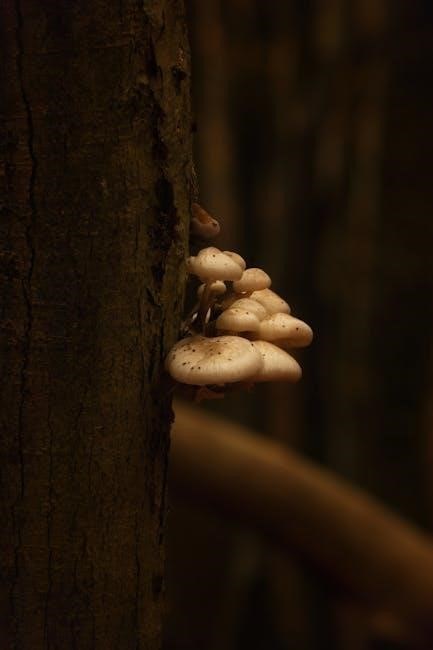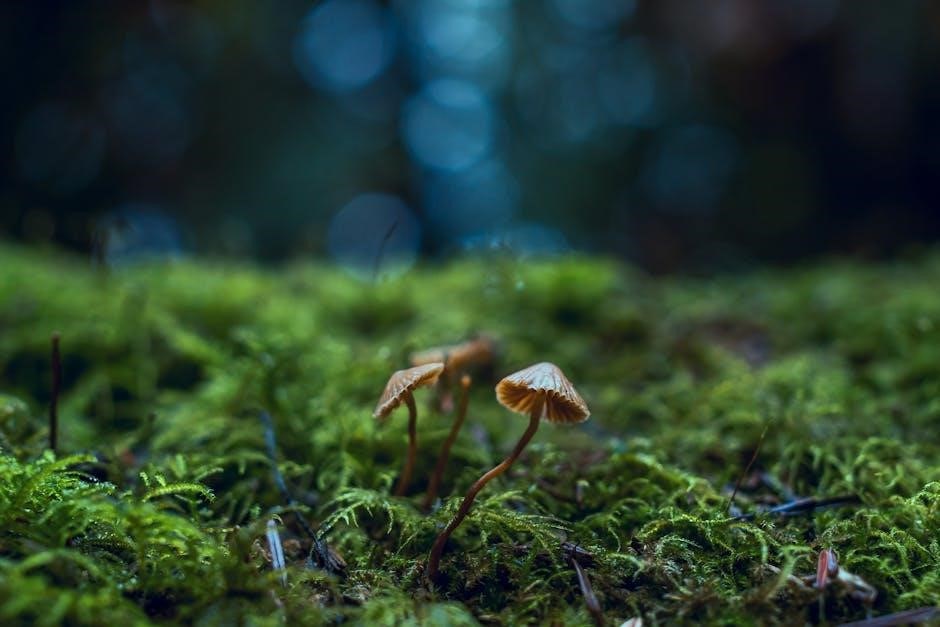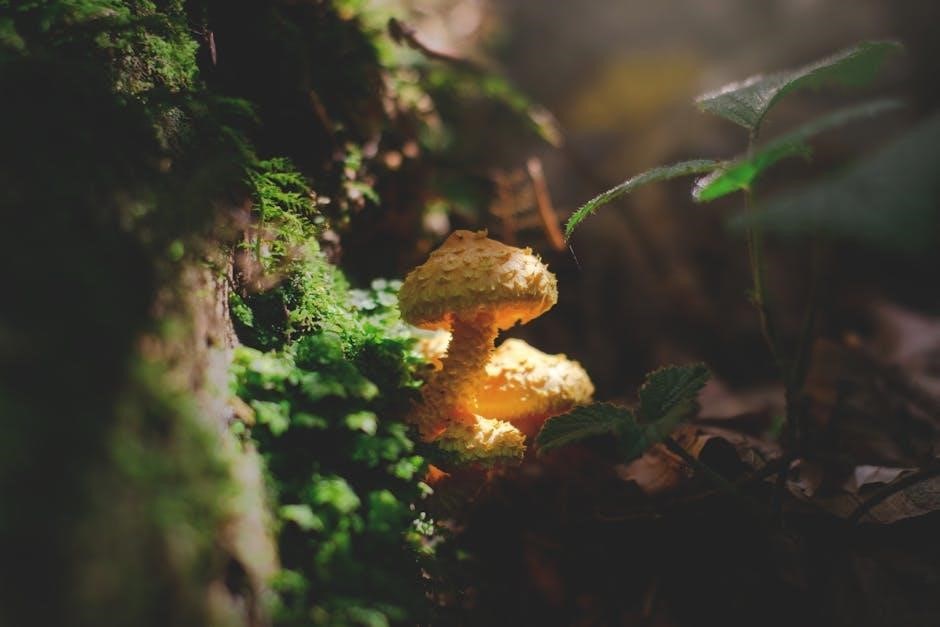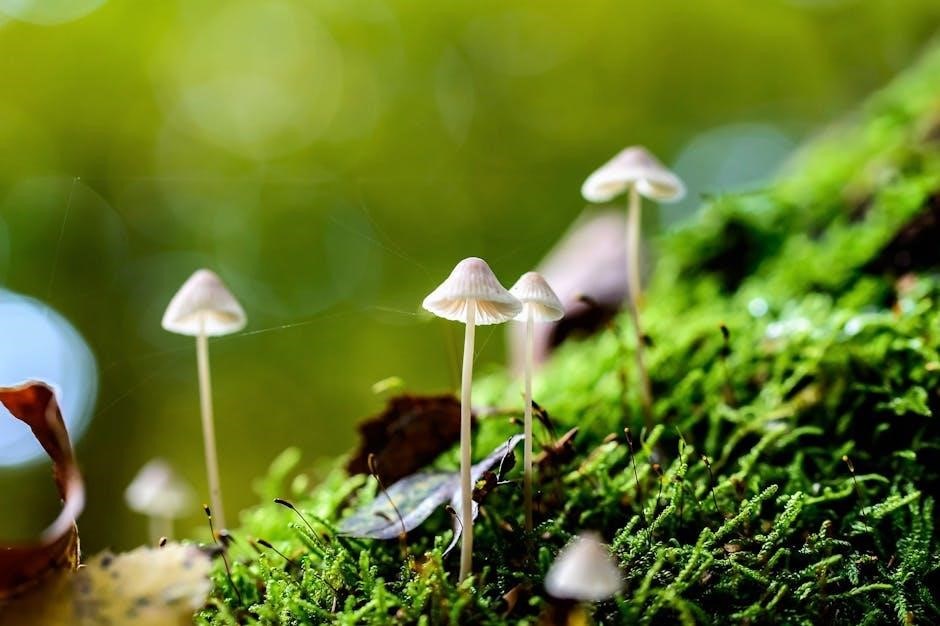Mushrooms are fascinating and diverse organisms, belonging to the fungi kingdom. They play vital roles in ecosystems, from decomposition to forming symbiotic relationships with plants. With over 15,000 known species, mushrooms offer a wide range of culinary, medicinal, and ecological significance. Understanding their biology and importance is essential for appreciation and safe utilization in both wild and cultivated environments.
Mushroom Identification
Mushroom identification is complex, requiring careful observation of spore color, habitat, and physical features. Accurate identification is crucial due to the risk of poisoning from poisonous species.
2.1. Key Features for Identification
Identifying mushrooms requires examining several key features. The cap shape, size, color, and whether it changes with age are crucial. The presence of gills, spores, and their color under the cap are vital, as spore print color helps narrow down species. The stem size, color, and texture, including rings or volvas, are important. The base of the stem often reveals hidden structures like bulbs or cups. Odor and taste can also aid identification, though caution is advised. Habitat and seasonal growth patterns provide additional clues. Accurate identification often requires a combination of these traits, as single features can be misleading. Consulting field guides and expert resources is essential for novices to ensure safety and accuracy when identifying wild mushrooms.
2.2. Common Mushroom Species
Several mushroom species are widely recognized and encountered. The Morel (Morchella spp.) is prized for its honeycomb-like appearance and earthy flavor. Chanterelle (Cantharellus cibarius) mushrooms are known for their fruity aroma and peach-colored, funnel-shaped caps. The Button Mushroom (Agaricus bisporus) is a common cultivar, often found in supermarkets. Crimini and Portobello mushrooms, also part of the Agaricus genus, are popular for their versatility in cooking. Wild species like the Oyster Mushroom (Pleurotus ostreatus) and Shiitake (Lentinula edodes) are valued for their rich flavors. Each species has unique characteristics, such as cap shape, stem texture, and habitat preferences, making them identifiable in diverse environments. Understanding these common varieties helps enthusiasts appreciate their diversity and ecological roles.
2.3. Edible vs. Poisonous Mushrooms
Distinguishing between edible and poisonous mushrooms is critical, as some species can be deadly; Edible mushrooms, like the Morel (Morchella spp.) and Chanterelle (Cantharellus cibarius), are prized for their unique flavors and textures. They often have distinctive features, such as Morels’ honeycomb-like appearance or Chanterelles’ fruity aroma. In contrast, poisonous mushrooms, such as the Amanita species (e.g., Destroying Angel and Death Cap), can cause severe illness or death. These mushrooms may look similar to edible varieties but have subtle differences, like the presence of a bulbous base or specific gill colors. Proper identification requires careful observation of features like spore color, habitat, and growth patterns. Always consult expert guides or professionals to ensure safety when foraging or consuming wild mushrooms.

Types of Mushrooms
Mushrooms come in diverse shapes, sizes, and species, categorized into wild, cultivated, and rare varieties. Each type offers unique culinary, medicinal, and ecological benefits, making them invaluable.
3.1. Wild Mushrooms
Wild mushrooms are found in various natural habitats, thriving in forests, fields, and woodlands. They come in a wide array of species, each with unique characteristics and growth patterns. Some popular varieties include chanterelles, porcini, and morels, which are highly prized for their flavor and texture. Wild mushrooms often have a stronger, earthier taste compared to cultivated ones. They can form symbiotic relationships with trees, contributing to nutrient exchange in ecosystems. Identifying wild mushrooms requires expertise, as some species can be poisonous. Proper knowledge and caution are essential for safe foraging and enjoyment of these natural delicacies. Their diversity and complexity make them a fascinating subject for study and culinary exploration.
3.2. Cultivated Mushrooms
Cultivated mushrooms are grown in controlled environments, ensuring consistent quality and flavor. Popular varieties include button, cremini, and portobello mushrooms, which are widely available in supermarkets. These mushrooms are bred for their mild taste and versatility in cooking, making them ideal for various dishes. Cultivated mushrooms are typically easier to produce and have a longer shelf life compared to wild species. They are also less risky to consume, as their growth conditions are monitored to avoid contamination. Many cultivated mushrooms are rich in nutrients, including vitamins and antioxidants, contributing to their popularity in both everyday meals and gourmet cuisine. Their adaptability to different recipes and reliable supply make them a staple in kitchens worldwide, offering a delicious and sustainable option for mushroom enthusiasts.
3.3. Rare and Exotic Species
Rare and exotic mushroom species are highly sought after for their unique flavors and limited availability. The truffle, considered one of the most luxurious, is prized for its intense aroma and flavor, often used in high-end cuisine. Other exotic varieties like the matsutake, known for its spicy scent, and the lion’s mane, with its distinctive cascade of white spines, offer unparalleled culinary experiences. These mushrooms often thrive in specific, hard-to-reach environments, making them difficult to cultivate and harvest. Their rarity and exclusivity contribute to their high value, attracting mushroom enthusiasts and chefs worldwide. Some species, like the golden chanterelle, are found in remote forests, adding to their allure. These rare fungi not only diversify the world of mushrooms but also inspire exploration and appreciation for nature’s hidden gems.

Foraging for Mushrooms
Mushroom foraging is an exciting adventure, requiring patience and knowledge. Forests, grasslands, and woodlands are prime locations, often hiding species like chanterelles, oyster mushrooms, and truffles. Timing is key, as mushrooms thrive in specific seasons and conditions, such as after rainfall or near decaying wood. Experienced foragers emphasize the importance of using field guides to ensure safe and successful hunts, transforming the hobby into a rewarding connection with nature.
4.1. Best Locations for Mushroom Foraging
Mushrooms thrive in diverse environments, making various ecosystems ideal for foraging. Forests, particularly those with coniferous or broadleaf trees, are hotspots for species like chanterelles and boletes. Woodlands, especially near decaying logs or tree stumps, often harbor oyster mushrooms and honey mushrooms. Grasslands and meadows can yield puffballs and fairy rings, while wetland areas near streams may host rare varieties. Rich soil with leaf litter in temperate regions is perfect for species like morels and truffles. Coastal areas and mountainous regions also provide unique habitats for exotic fungi. Timing is crucial, as most mushrooms appear after rainfall or in cooler seasons. Using field guides and local knowledge can help pinpoint these locations effectively, ensuring a successful and enjoyable foraging experience.
4.2. Field Guides for Mushroom Hunters
Field guides are indispensable tools for mushroom hunters, providing detailed information to identify species accurately. They typically include high-quality images, descriptions of key features, and tips for distinguishing edible from poisonous varieties. Many guides are tailored to specific regions, ensuring relevance to local fungi. For beginners, guides like the Audubon Field Guide to Mushrooms offer clear, concise information. Advanced hunters may prefer specialized books such as Mushrooms Demystified, which covers a broader range of species; Digital apps like Mushroom Identifier are also popular, offering interactive identification tools. Using a field guide helps ensure safe and successful foraging, allowing enthusiasts to explore the fascinating world of fungi with confidence and precision.

Culinary Uses of Mushrooms
Mushrooms add versatility and depth to various cuisines, offering earthy flavors and meaty textures. They enhance dishes from soups to sauces, serving as a delicious, nutritious ingredient.
5.1. Popular Mushroom Recipes

Mushrooms are a versatile ingredient in countless dishes worldwide. One of the most beloved recipes is creamy mushroom pasta, blending sautéed mushrooms with garlic, cream, and herbs over pasta. Another favorite is mushroom risotto, an Italian classic featuring Arborio rice, white wine, and stock. Stuffed mushrooms are a delightful appetizer, filled with cheese, breadcrumbs, and spices. For a hearty option, French onion soup with mushrooms combines caramelized onions, beef broth, and melted cheese. Additionally, mushroom stir-fries are a quick and nutritious choice, pairing mushrooms with soy sauce, vegetables, and your choice of protein. These dishes showcase the rich, earthy flavor of mushrooms in diverse culinary traditions.
5.2. Pairing Mushrooms with Other Ingredients
Mushrooms are incredibly versatile and can be paired with a variety of ingredients to enhance their natural umami flavor. Garlic and herbs like thyme or rosemary complement their earthy taste, creating aromatic dishes. Dairy products such as cheese, cream, and butter are classic pairings, adding richness to mushroom-based sauces or soups. Wine, especially red or white varieties, elevates mushroom flavors in French-inspired cuisine. For vegetarians and vegans, mushrooms pair beautifully with plant-based ingredients like lentils, spinach, and roasted vegetables. Nuts or seeds can add texture and depth to mushroom-centric meals. The key is to balance bold flavors while allowing the unique characteristics of the mushrooms to shine. This versatility makes mushrooms a cornerstone in diverse culinary traditions.
5.3. Storage and Preparation Tips
Mushrooms are best stored in a cool, dry place to maintain freshness. Use a paper bag or breathable container to prevent moisture buildup, which can cause spoilage. Avoid washing mushrooms before storing, as excess moisture can lead to sogginess. Instead, gently brush off dirt with a soft brush or clean cloth prior to use. For preparation, mushrooms can be sautéed, roasted, or grilled to enhance their natural umami flavor. Slice or chop them just before cooking to preserve texture and aroma. Adding a pinch of salt during cooking helps draw out moisture and intensify flavors. Experiment with herbs, garlic, and wine for added depth. Proper storage and preparation techniques ensure mushrooms remain a delicious and versatile ingredient in various dishes.

Leave a Reply
You must be logged in to post a comment.